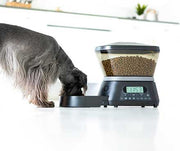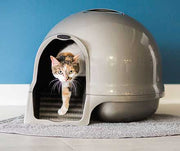4 Reasons You Need a Pet Water Fountain

Are you getting tired of cleaning and refilling your pet's water dish every day? Or has your dog or cat been struggling with dehydration and not drinking enough water, despite all of your attempts to make it more appealing? If you're looking for a convenient solution to these problems, it might be worth getting a pet water fountain.
WHAT IS A PET WATER FOUNTAIN?
Pet water fountains, also called automatic waterers, are similar to automatic pet feeders, except they are filled with water rather than food. Like automatic feeders, there are a variety of options available, but the premise of them is the same – they will provide a continuous flow of water into a dish for your pet. Some of them use gravity to replenish the water while others plug into the wall and run like a fountain.
If you're considering getting a pet water fountain for your dog or cat but are still unsure if it will be worth it, check out some of the following benefits.
REASONS TO GET AN AUTOMATIC WATERER

1. Your Pet Will Have Access To Fresh Water At All Times.
One of the biggest benefits of a pet water fountain is that will keep your pet's water fresh so that you don't have to. If you have a dog or cat who is very particular about the state of their water, an automatic waterer might be your best bet. It's especially convenient for pet owners who have busy schedules or on hotter days in which you would usually find yourself refilling your pet's water bowl constantly. Because many pet water fountains have a large reservoir and can store a decent amount of water, they won't run out as fast as a regular water bowl.
2. It Filters The Water.
Filtered water doesn't just taste better, it is also better for you and your pet. An automatic waterer will continually filter the water as it goes back into the dish, removing elements such as fur, dirt, or other impurities that could pollute water or be harmful to your dog or cat to ingest.
Some dogs or cats struggle to get enough water on a daily basis not because they don't have access to it, but simply because they are uninterested. An automatic waterer can help fix this issue. The noise and movement of the water flowing into the dish will likely pique your pet's interest and remind them to have a drink!
4. The Water Stays Cool.
Cooler water is always more refreshing than lukewarm water that's been sitting out for a long time. Many automatic waterers will keep the temperature of the water cooler since it is constantly running. While it may not seem like a big deal on the surface, cooler water will be more enticing to your pet.
HOW TO TAKE CARE OF AN AUTOMATIC WATERER
If you've decided to invest in an automatic waterer, be sure you take proper care of it by cleaning it regularly. We recommend cleaning it at least once per week if not more often. This way, you'll regularly get rid of any nasty bacteria or other elements that can build up over time. Also, it's a good idea to replenish your pet's water once a day. While automatic waterers work to keep the water fresh and filtered, you will still want to change it out on a daily basis.
Here are a few tips for both gravity waterers as well as pet water fountains when it comes to caring and cleaning:
GRAVITY WATERERS
Cleaning: Use warm water and soap to rinse out the dish as well as the inside of the water bottle. You may also want to use a bottle brush for some of those hard-to-reach spots. After washing with soap, be sure you rinse every item of the gravity waterer so that there is no soap left behind. Check out this article for more specific cleaning instructions for your gravity waterer.

PET WATER FOUNTAINS
Cleaning: When it comes to cleaning an automatic waterer, it may require a bit of disassembling so that you can reach all the pieces that need to be cleaned. Look at the instructions of your specific waterer to see how you can safely take it apart. Use warm water and soap to clean all of the parts, and be sure you rinse out the motor to get rid of any debris.
Filters: In addition to regularly cleaning your pet's water fountain, you'll want to stay on top of replacing its water filter. How often you will need to replace it will depend on the type of fountain and filter you use. On average, a filter should be replaced every 2 to 4 weeks.
One more thing to note is that if you decide to wash any component of your pet's waterer in your dishwasher, don't want them with your dishes. You don't want to risk spreading any harmful bacteria from your pet's dishes to yours. Be sure to also check with your specific waterer to make sure that it is safe to put in the dishwasher.
Additional Resources:
- https://www.petguide.com/products/dishware/dog/pros-and-cons-of-continuous-water-fountains-for-pets/
- https://shedhappens.net/pet-water-fountain-benefits/
- https://yourdogadvisor.com/dog-water-fountain/#Could_Your_Dog_Benefit_From_Using_A_Dog_Water_Fountain
- https://petloverguy.com/how-clean-cat-water-fountain/
- https://www.wellnesspetfood.com/blog/how-often-should-you-change-your-pets-water
Previous article

Next article

Related posts
View all-

Top Benefits of Using an Airtight Container for Your Dog's Food
This blog will explore the top benefits of using airtight containers for dog food storage. We will discuss how these containers can extend the shelf life of dry dog food, preserve its nutritional value, and prevent contamination from air and moisture. Knowing the best practices for dog food storage can significantly affect whether you use plastic or stainless steel containers. Read Article -

Different Types of Cat Beds
Whether you're already a cat owner or you are thinking of adopting a new kitty into your home, cat beds are a necessity for your furry friend! Read Article -

Why Dogs Lick Their Paws & When You Should Worry
Like cats, self-grooming is also normal for dogs. It's part of their process, especially when they come inside the house after walking around outdoors. But, as with other dog behaviors, excessive paw licking can be an indication that there's something wrong. Read Article



